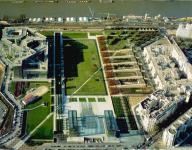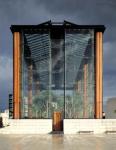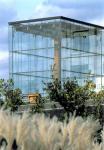This Park is the fourth perspective on Paris’ left bank.
Its character and its orientation towards the Seine make it comparable to the Jardin des Plantes, the Champs de Mars and the Invalides. It draws upon and builds on the characteristic traits of these founding large public open spaces. The Park is permeated by the city, just as the Park itself permeates the city.
The way in which its boundaries have been designed heralds a new relationship between urban and natural landscapes; there is fusion of architecture and vegetation – the stability of the architectural forms highlights the motion of the vegetation’s textures.
The landscape is shaped by the juxtaposition of architectural material and plant-based material.
Each constructed form presents a themed garden.
The palisades and ramps, stone waterways, monolithic fountains, pools and podiums reveal the shapes and forms of the movement of water, light and vegetation.
There is no other narrative than this approach to motion as the image of nature.
The Serial Greenhouses give free rein to the development of the creepers and fragile trees contained within them.
The footbridges leading to them navigate their way through the mass of foliage of the trees which line them. Seats and benches offer the chance to rest in various positions.
The tranquillity of the architecture frames or lends focus to the gardens’ variations which can be touched and passed through, representing nothing but the play of their textures, their colours, their movement and their substance in its original state.
Two large greenhouses form the background of the Park’s general perspective. The pillars and monolithic doors contrast with the weightlessness of their glazing. One holds an austral garden, while the other contains an orangery which can also be used for exhibitions.
Their dimensions, {15 metres high, 15 metres wide and 45 metres long}, as well as the fountains and waterways in the square they enclose, lend symbolism to the garden on a scale befitting Paris.
© Patrick Berger
1985
1992


.jpg)


